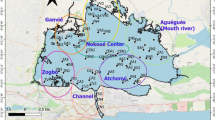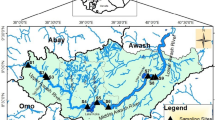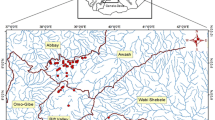Abstract
The Water Framework Directive (WFD) recognizes benthic macroinvertebrates as a good biological quality element for transitional waters as they are the most exposed to natural variability patterns characteristic of these ecosystems, due to their life cycles and space-use behavior. In this paper we consider the performance of three multimetric indices (namely M-AMBI, BITS and ISS) based on benthic macroinvertebrates abundances, aiming at assessing the ecological status of lagoons and likely to respond differently to different sources of stress and natural variability. In order to investigate the possible contrasting behavior of the three multimetric indices, we propose a Bayesian hierarchical model in which they are jointly modeled as functions of abiotic covariates, external anthropogenic pressure indicators and lagoon effects. The proposed model is applied to data from three lagoons in Apulia and assessed using multiple diagnostic tools. The joint sensitivity of lagoon quality evaluations to available covariates is thus investigated.







Similar content being viewed by others
References
Arima S, Basset A, Jona Lasinio G, Pollice A, Rosati I (2013) A hierarchical bayesian model for the ecological status classification of lagoons. Ecol Model 263:187–195
Barbone E, Rosati I, Reizopoulou S, Basset A (2012) Linking classification boundaries to sources of natural variability in transitional waters: a case study of benthic macroinvertebrates. Ecol Indic 12:105–122
Basset A, Sabetta L, Fonnesu A, Mouillot D, Do Chi T, Viaroli P, Reizopoulou S, Carrada G (2006) Typology in mediterranean transitional waters: new challenges and perspectives. Aqua Conser Marine Freshwater Ecosys 16:441–445
Basset A, Barbone E, Borja A, Brucet S, Pinna M, Quintana X, Reizopoulou S, Rosati I, Simboura N (2012) A benthic macroinvertebrate size spectra index for implementing the water framework directive in coastal lagoons in mediterranean and black sea. Ecol Indic 12:72–83
Basset A, Barbone E, Elliott M, Li B, Jorgensen S, Lucena-Moya P, Pardo I, Mouillot D (2013) A unifying approach to understanding transitional waters: fundamental properties emerging from ecotone ecosystems. Estuarine Coastal Shelf Sci 132:5–16
Borja A, Franco J, Perez V (2000) A marine biotic index to establish the ecological quality of soft-bottom benthos within european estuarine and coastal environments. Marine Pollut Bull 40:110–114
Borja A, Franco J, Valencia V, Bald J, Muxika I, Belzunce M, Solaun O (2004) Implementation of the european water framework directive from the basque country (northern spain): a methodological approach. Marine Pollut Bull 48:209–218
Borja A, Barbone E, Basset A, Borgersen G, Brkljacic M, Garmendia J, Marques J, Mazik K, Muxika I, Neto J, Norling K, Rodriguez J, Rosati I, Rygg B, Texteira H, Trayanova A (2011) Response of single benthic metrics and multi-metric methods to anthropogenic pressure gradients, in five distinct europen coastal and transitional ecosystems. Marine Pollut Bull 62:499–513
Brynjarsdóttir A, Gelfand A (2014) On covariate importance for regression models with multivariate response. Submitted, pp 1–37
Clark JS, Bell DM, Kwit M, Powell, A, Zhu K (2013) Dynamic inverse prediction and sensitivity analysis with high-dimensional responses: Application to climate-change vulnerability of biodiversity. J Agri Biol Environ Statis 18:376–404
Gelman A, Meng XL, Stern H (1996) Posterior predictive assessment of model fitness via realized discrepancies. Statistica Sinica 6:733–807
Ji J-H, Chang N-B (2005) Risk assessment for optimal freshwater inflow in response to sustainability indicators in semi-arid coastal bay. Stoch Environ Res Risk Assess 19:111–124
Lucena-Moya P, Pardo I, Alvarez M (2009) Development of a typology of transitional waters in mediterranean ecoregion: the case of the islands. estuarine, coastal and shelf. Science 82:61–72
Marchini A, Marchini C (2006) A fuzzy logic model to recognise ecological sectors in the lagoon of venice based on the benthic community. Ecol Model 193:105–118
Meng XL (1994) Posterior predictive p-values. Ann Statis 22(3):1142–1160
Mistri M, Munari C (2008) Bits: a smart indicator for self-bottom, non-tidal lagoon. Marine Pollut Bull 56:597–599
Muxika I, Borja A, Bald J (2007) Using historical data, expert judgement and multivariate analysis in assessing reference conditions and benthic ecological status, according to the european water framework directive. Marine Pollut Bull 55:16–29
Piffady J, Parent E, Souchon Y (2013) A hierarchical generalized linear model with variable selection: studying the response of a representative fish assemblage for large european rivers in a multi-pressure context. Stoch Environ Res Risk Assess 27:1719–1734
Plummer M (2003) Jags: a program for analysis of bayesian graphical models using gibbs sampling. Proceedings of the 3rd international workshop on distributed statistical computing (DSC 2003), March. AUSTRIA, Vienna, pp 20–22
Sadiq R, Tesfamariam S (2008) Developing environmental indices using fuzzy numbers ordered weighted averaging (fn-owa) operators. Stoch Environ Res Risk Assess 22:495–505
Su S, Zhang Z, Xiao R, Jiang Z, Chen T, Zhang L, Wu J (2012) Geospatial assessment of agroecosystem health: development of an integrated index based on catastrophe theory. Stoch Environ Res Risk Assess 26:321–334
Viaroli P, Mistri M, Trousselier M, Gierzoni S, Cardoso A (2005) Structure, functions and ecosystem alterations in southern european coastal lagoons. Hydrobiologia 550:57–71
Author information
Authors and Affiliations
Corresponding author
Rights and permissions
About this article
Cite this article
Pollice, A., Arima, S., Jona Lasinio, G. et al. Bayesian analysis of three indices for lagoons ecological status evaluation. Stoch Environ Res Risk Assess 29, 477–485 (2015). https://doi.org/10.1007/s00477-014-0885-4
Published:
Issue Date:
DOI: https://doi.org/10.1007/s00477-014-0885-4




